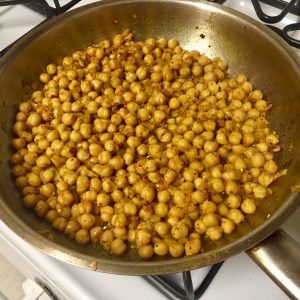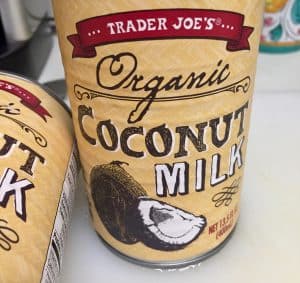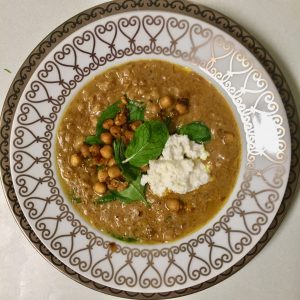
This recipe landed in my inbox in a collection of the 10 Most-Popular recipes in The New York Times. Turns out the Times runs posts of its Most Popular recipes so frequently, that I cannot tell you what time frame they’re referring to. However, the recipe was first published right after Thanksgiving this year. Since I have resolved to cook with more plant protein and less animal protein, I was really excited to see it. I’ve had huge success with a Chickpea recipe in the past so I was drawn to this one. (There’s a link to that recipe after this one. Do check it out) I cooked it and we loved it. Chickpeas are added to a spicy mix of garlic, lots of ginger and yellow onion. They crisp away on the stove sizzling along in the pan. When they’re cooked, you put a cup of the chickpeas aside to top the finished stew. Red Chili Pepper and Turmeric go in with coconut milk and stock added after you’ve crushed the chickpeas to thicken the stew. It bubbles away, a lot longer than the recipe indicated. The final ingredient—a choice of greens—is added, the stew is ladled out, topped with the reserved chickpeas, mint and a dollop of yogurt. I actually topped mine with Ricotta since we had no plain yogurt in the house. It’s sublime! But little did I know what wild controversy there is surrounding this wonderful dish.

I always like to put recipes in context. So I circled back to the New York Times and discovered a lot more than I bargained for. Alison Roman had written an introduction to her recipe which seemed fairly innocuous to me. It was titled “Creamy Hearty and (Sort of) Virtuous.” In it, she made a case for not labeling recipes. In her example she wrote “Call it vegetarian and I will convince myself that whatever it is would have been better with sausage in it”. Ms. Roman went on to say that this almost vegetarian recipe (you can use chicken stock in it) is ‘a hearty, creamy, heavily spiced stew that just happens to be free of meat or dairy and full of protein and leafy greens.” She wouldn’t label the stew vegetarian because it might turn off omnivores. Sounds reasonable to me.

Well, the readers of The New York Times were having none of that. Bang at the top of the Comments was a woman who ridiculed the dish pointing out the fat content of coconut milk. She claimed she’d done ‘some quick nutritional calculations’ and the dish has more saturated fat (32 grams) than a woman should eat in a day ‘making this a decidedly UNhealthy recipe’. So much for any “(Sort of) Virtuous” label for this reader. But “Suzy” of New York was the tip of the iceberg. “Why on earth is Roman apologizing for offering a vegetarian recipe and why is she refusing the label it as such. Afraid of annoying her Republican in-laws or something?” (I had no clue Republicans were anti-vegetarian, did you?) From there, the comments descended into rather predictable Times talk about saving the planet. Good lord it’s a stew. And a darned good one. And here is the recipe:
Spiced Chickpea Stew with Coconut and Turmeric
A luscious creamy-rich stew spiked with spice and coconut flavor through and through. A glorious dish on a cold night.

Ingredients
- ¼ cup olive oil, plus more for serving
- 4 garlic cloves, chopped
- 1 large yellow onion, chopped
- 1 (2-inch) piece ginger, finely chopped
- Kosher salt and black pepper
- 1 ½ teaspoons ground turmeric, plus more for serving
- 1 teaspoon red-pepper flakes, plus more for serving
- 2 (15-ounce) cans chickpeas, drained and rinsed
- 2 (15-ounce) cans full-fat coconut milk
- 2 cups vegetable or chicken stock
- 1 bunch Swiss chard, kale or collard greens, stems removed, torn into bite-size pieces
- 1 cup mint leaves, for serving
- Yogurt, for serving (optional)
- Toasted pita, lavash or other flatbread, for serving (optional)
Directions
- Step 1 Heat oil in a large pot over medium heat. Add garlic, onion and ginger. Season with salt and pepper and cook, stirring occasionally until onion is translucent and starts to brown a little around the edges, 3 to 5 minutes.
- Step 2 Add turmeric, red-pepper flakes and chickpeas, and season with salt and pepper. Cook, stirring frequently, so the chickpeas sizzle and fry a bit in the spices and oil, until they’ve started to break down and get a little browned and crisp, 8 to 10 minutes. Remove about a cup of chickpeas and set aside for garnish.
- Step 3 Using a wooden spoon or spatula, further crush the remaining chickpeas slightly to release their starchy insides (this will help thicken the stew). Add coconut milk and stock to the pot, and season with salt and pepper. Bring to a simmer, scraping up any bits that have formed on the bottom of the pot. Cook, stirring occasionally, until stew has thickened and flavors have started to come together, 30 to 35 minutes. (Taste a chickpea or two, not just the liquid, to make sure they have simmered long enough to taste as delicious as possible.) If after 30 to 35 minutes you want the stew a bit thicker, keep simmering until you’ve reached your desired consistency. Determining perfect stew thickness is a personal journey!
- Step 4 Add greens and stir, making sure they’re submerged in the liquid. Cook a few minutes so they wilt and soften, 3 to 7 minutes, depending on what you’re using. (Swiss chard and spinach will wilt and soften much faster than kale or collard greens.) Season again with salt and pepper.
- Step 5 Divide among bowls and top with mint, reserved chickpeas, a sprinkle of red-pepper flakes and a good drizzle of olive oil. Serve alongside yogurt and toasted pita if using. Dust the yogurt with turmeric if you’d like.
Here’s another great Chickpea recipe:
Braised Chickpeas with Spinach and Haloumi with Crisp Onions and Mojo Verde














Don’t know what it is, but this goes together fabulously. Great intro for garbanzo and coconut milk cooks. Of course I soaked my own beans.
Thanks so much for taking the time to write. This is a wildly popular recipe–and for good reason. Really delightful combination. Bon Appetit!